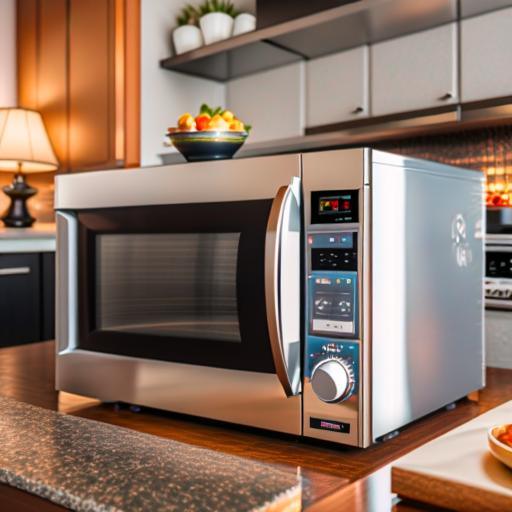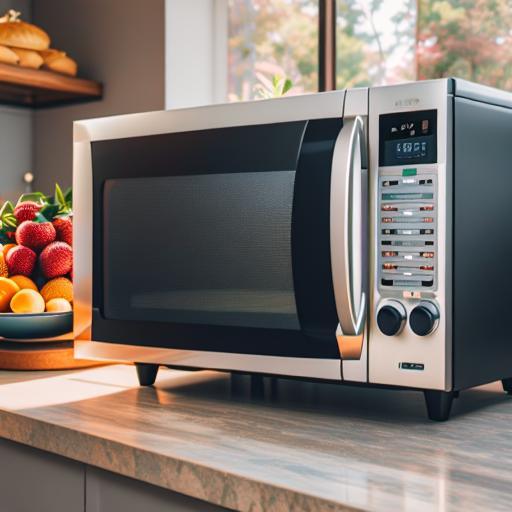This post contains affiliate links. See the affiliate disclaimer here.
Cooking and reheating food quickly is one of the main conveniences of using a microwave oven. But have you ever wondered how hot microwaves actually get to cook your food so fast? In this article, we’ll delve into the world of microwave heating and explore just how hot these kitchen appliances can get.
Most standard home microwaves reach interior temperatures between 200-300 degrees Fahrenheit, which is significantly lower than the 550-degree temperatures of a conventional oven. However, don’t let the lower temperature fool you. Microwaves rely on a completely different heating mechanism than traditional ovens, allowing them to cook food faster despite the lower temperatures.
How Do Microwaves Work?

Microwaves work by using electromagnetic waves to heat up food. These waves are generated by the microwave itself and are then sent into the food. The waves cause the water molecules in the food to vibrate, which in turn creates heat.
The highest temperature a microwave can reach depends on a few factors, such as the size and power of the microwave. Generally, household microwaves have a power of about 700 watts, which results in a maximum temperature of about 100 degrees Celsius. However, there are some models that can reach higher temperatures, up to 200 degrees Celsius.
To heat your food quickly, the microwave employs several components, but the most important one is the Magnetron, which converts electricity to microwaves. Other components include a waveguide that channels the waves from the Magnetron to the food compartment, a stirrer to circulate the microwaves around the food compartment, and a turntable to rotate the food so that all sections are heated evenly.
It’s important to note that it’s not the microwave itself that gets hot, but rather the food or object that’s inside. Even models with temperature probes are actually telling you how hot the food is, not how hot the microwave is. So, the right question to ask is not “what’s the maximum temperature a microwave can reach,” but rather “what’s the maximum temperature objects can reach in a microwave.”
Understanding how microwaves work and the temperature range they can reach can help you make informed decisions when cooking or reheating food using a microwave oven.
The Difference in Temperature: Microwaves vs. Conventional Ovens
When it comes to cooking, understanding the temperature differences between microwaves and conventional ovens is essential. Microwave ovens operate at a range of 200-300 degrees Fahrenheit, while conventional ovens typically use temperatures between 350-550 degrees Fahrenheit. This variance in temperature plays a significant role in how each type of oven cooks food.
Microwaves work by emitting electromagnetic waves that cause water molecules in food to vibrate rapidly, generating friction heat from the inside out. This internal molecular heating allows food to cook very quickly, often in just a fraction of the time it takes in a conventional oven. The direct interaction between the waves and food molecules creates enough heat to cook meals rapidly, even at lower temperatures.
On the other hand, conventional ovens rely on hot dry air to transfer heat gradually into food through the surface of dishes and pans via conduction. This method takes longer than microwave cooking because the heat has to penetrate the outer layers of the food and travel inward. As a result, conventional ovens require higher temperatures to achieve the same level of cooking as a microwave.
The difference in temperature between microwaves and conventional ovens has significant implications for cooking speed and efficiency. While conventional ovens may reach higher temperatures, their slower conduction heat transfer takes more time for the heat to reach the center of the food. This results in longer cooking times compared to microwaves, which cook food very quickly from the inside out.
It’s important to note that commercial microwaves can take things to the extreme, reaching temperatures of up to 500 degrees Fahrenheit for fast, high-volume cooking. These models are specifically designed to handle the demands of commercial kitchens.
The temperature range of microwaves and conventional ovens is distinct, with microwaves operating at lower temperatures but still delivering rapid cooking times. By directly energizing food molecules, microwaves can cook food much faster than traditional ovens, making them a convenient option for busy individuals who want to prepare meals quickly.
Exploring the Heating Mechanism of Microwaves
Understanding the heating mechanism of microwaves is key to answering the question of how hot they can get. Unlike conventional ovens that rely on hot air and conduction, microwaves use a different method called dielectric heating.
Dielectric heating occurs when microwaves emit electromagnetic waves that penetrate the food and cause water molecules to vibrate rapidly. These vibrations generate heat from the inside out, cooking the food quickly and efficiently.
The microwaves themselves do not get hot, and the temperature they reach depends on the power output and the cooking time. Most standard home microwaves can reach interior temperatures between 200-300 degrees Fahrenheit. Though it may seem lower than the temperatures reached by conventional ovens, the rapid and direct heating method of microwaves allows them to cook food faster despite the lower temperatures.
Factors such as the type of food being cooked, its moisture content, and the size and shape of the container can also influence the temperature reached in a microwave. Foods with higher water content tend to heat more quickly, while items with low water content may reach lower temperatures.
Commercial and specialty microwaves, designed for high-volume cooking, can reach even higher temperatures. Some models can reach up to 500 degrees Fahrenheit, making them suitable for quick and efficient cooking in professional kitchens and food establishments.
When using a microwave, it’s important to consider safety considerations. As the food reaches high temperatures, steam can build up inside containers and cause potential hazards. To avoid this, make sure to use microwave-safe dishes and containers that can withstand the heat and allow steam to escape safely.
Understanding how the heating mechanism of microwaves works can help you use your microwave more effectively and safely. By harnessing its speed-cooking superpowers, you can enjoy the convenience of quickly cooked meals without compromising on taste or quality.
So, next time you’re using your microwave, remember that it’s the dielectric heating and the rapid vibrations of water molecules that make it possible for your food to reach the desired temperature quickly.
Understanding the Importance of Microwaves’ Lower Temperatures
Microwaves are known for their ability to cook food quickly and efficiently. One of the key factors that sets them apart from conventional ovens is their lower operating temperatures. While conventional ovens rely on hot air and conduction, microwaves use a different heating mechanism that allows them to cook food faster at lower temperatures.
The lower temperatures of microwaves are made possible by the emission of electromagnetic waves. These waves cause water molecules in the food to vibrate rapidly, generating heat from the inside out. This direct interaction with food molecules allows microwaves to cook meals rapidly without the need for excessive heat.
The advantage of lower temperatures is twofold. First, it reduces the cooking time significantly. For example, a microwave operating at 212 degrees Fahrenheit (100 degrees Celsius) can quickly boil water in just minutes. In comparison, a conventional oven would need to reach the same temperature to produce steam and cook food effectively. The rapid heating process of microwaves allows you to prepare meals in a fraction of the time it would take with a conventional oven.
Secondly, lower temperatures preserve the quality and taste of your food. The quick and efficient cooking process of microwaves helps to retain the moisture and natural flavors of the food. With conventional ovens, the longer cooking time at higher temperatures can lead to drying out or overcooking, which can result in a loss of taste and texture.
Understanding the importance of microwaves’ lower temperatures allows you to take full advantage of their efficient cooking capabilities. By using electromagnetic waves to heat food from the inside out, microwaves offer faster cooking times without compromising on taste and quality. So the next time you need to cook a meal in a hurry, consider reaching for your microwave and enjoy delicious and perfectly cooked food in no time.
Conclusion
Microwaves are an essential kitchen appliance that offers fast and efficient cooking. Unlike traditional ovens, microwaves utilize electromagnetic waves to cook food from the inside out. This unique heating mechanism allows for lower operating temperatures while still achieving quick and even cooking results.
By harnessing the power of microwaves, you can significantly reduce cooking time without compromising the quality and taste of your meals. The ability to cook from the inside out ensures that your food retains its moisture, texture, and nutrients.
Understanding how microwaves work is key to maximizing their efficiency. By following proper cooking guidelines and utilizing the various power settings, you can achieve perfectly cooked meals in no time. Whether you’re reheating leftovers, defrosting frozen items, or preparing a quick meal, microwaves provide convenience without sacrificing taste.
Investing in a high-quality microwave can revolutionize your cooking experience. With their lower operating temperatures and rapid cooking capabilities, microwaves are a versatile and time-saving addition to any kitchen. Embrace the power of microwaves and enjoy delicious, hassle-free meals with ease.
Frequently Asked Questions
What happens if I’m in a microwave for 3 seconds?
Significant injury, including burns, blisters, pain, nerve damage, and tissue necrosis, can occur in as little as 2-3 seconds.
Is a microwave hotter than an oven?
Ovens can reach higher temperatures than microwaves, making them better for baking and roasting. Microwaves are better for reheating and defrosting.
Does the top of a microwave get hot?
Yes, the top of a microwave can get hot, particularly on the right side where the “nucotron” is located. Avoid placing anything on top of the microwave while in use to prevent potential melting or damage.
Why do microwaves heat up so fast?
Microwaves use electromagnetic waves to heat food from the inside out, allowing for faster cooking times at lower temperatures. This volumetric heating effect results in quicker processing rates compared to conventional heating techniques.
Is it safe to microwave for 10 minutes?
Microwaving for 10 minutes is generally safe if the microwave is in good working condition and there are no flammable materials or metal objects inside. Ensure proper ventilation and follow manufacturer’s instructions for safe usage.

